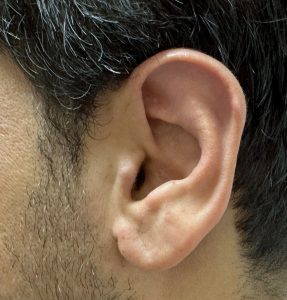Introduction
Vertical ear reduction—also known as vertical ear shortening or macrotia reduction—is a surgical procedure that decreases the overall height of the external ear while preserving its natural contour. It is performed when a patient has macrotia, a condition in which the ears are normally shaped but disproportionately tall. This procedure addresses ear height only and does not correct ear protrusion, which is treated with otoplasty.
Macrotia can involve excess height in one or more of the three anatomical thirds of the ear:
- Upper third (scapha)
- Middle third (conchal bowl)
- Lower third (earlobe)
Each region requires distinct surgical techniques. All approaches involve removing a wedge of skin and cartilage—except in the earlobe, which contains no cartilage—from one of the following areas:
- Scapha (upper ear)
- Conchal bowl (middle ear)
- Earlobe (lower ear)
Typically, 5–10+ mm of tissue is removed, depending on the degree of vertical excess.
Earlobe reduction is the most commonly performed isolated technique, since elongated earlobes alone are a frequent aesthetic concern. True macrotia reduction, however, usually requires reducing two of the three ear segments.
Upper Ear Shortening (Scapha Reduction)
- A horizontal or angled wedge of cartilage and skin is excised.
- The upper pole is advanced downward.
- The natural antihelical fold is preserved.
Middle Ear Shortening (Conchal Reduction)
- A transverse wedge of conchal, antihelical, and helical rim cartilage and skin is removed.
- This allows the upper and lower ear segments to be approximated.
Lower Ear Shortening (Earlobe Reduction)
- An inferior wedge of tissue is removed, raising the position of the lower helical rim.
- Ideal for correcting elongated earlobes.
The most common macrotia reduction approach combines upper and lower ear shortening, as this yields natural proportions with inconspicuous scars. However, in patients with an enlarged conchal bowl, this combination alone may accentuate the size of the concha, creating a disproportionate appearance.
Case Study
This male patient had been bothered by the size of his ears since childhood. His right ear measured 80 mm in vertical height, and his left measured 75 mm. Although all three regions of the ear were enlarged, the middle and lower thirds were disproportionately overdeveloped.

Discussion
Middle-third ear reduction is the least commonly performed macrotia technique. Its infrequent use is due to the more visible scar required across the central ear cartilage. While upper ear shortening also produces a transverse helical rim scar, the conchal reduction scar is longer and traverses the full cartilage framework.
However, in cases with significant conchal enlargement, reducing only the upper and lower thirds may result in an unnatural appearance. A large concha can prevent the ear from looking proportionate even if overall height is reduced.
Key Points
- In macrotia with a prominent conchal bowl, middle-third reduction may be more important than upper ear reduction for achieving optimal ear height.
- Conchal reduction carries the highest risk of visible scarring and potential need for revision.
- In this patient, reducing the middle and lower thirds resulted in a 20 mm decrease in ear height.
Barry Eppley, MD, DMD
World-Renowned Plastic Surgeon






